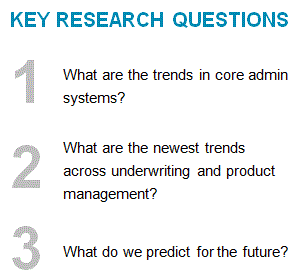Reinventing Underwriting: New Ingredients for the Secret Sauce
Abstract
 |
Innovation is exploding across all aspects of underwriting and product management. New technologies are transforming an old art. But if there is one lesson to be learned, it is that carriers whose systems are not already capable of handling these changes will be alarmingly disadvantaged. Underwriting is at the core of the insurance industry; it is the secret sauce. For hundreds of years, this process was accomplished through the individual judgment of highly experienced underwriters. Insights were captured in manuals of procedures and carefully taught to succeeding generations. |
Over the last few years, carriers have been heavily engaged in replacing core policy admin systems enabling a fundamental transformation of the underwriting process. Gone are the days of green eye shades and rating on a napkin, identical products across the industry, and standard rating algorithms used by all carriers.
Carriers are using their newly gained technology capabilities to create dramatically different products, develop innovative processes driving efficiency, improve decisions, and transform the customer experience. This transformation of underwriting is enabled by business rules to drive automated workflow, but, even more importantly, this is a story about the fundamental transformation of insurance through the application of data.
This report looks at underwriting and product management and describes some of the newest innovations in each area with specific examples provided where publicly available.
“What you’ll see is that almost every aspect of the underwriting and product management functions are being fundamentally transformed as carriers find new ways of utilizing and applying data,” says Karlyn Carnahan, a research director with Celent’s Insurance practice and author of the report. “Carriers are creating dramatically different products, developing innovative processes, and transforming the customer experience.”
Key findings in this report include:
- Carriers are using product innovation as a competitive differentiator and are experimenting with new types of insurance products that go well beyond basic indemnification in the event of loss. Parametric products, behavior-based products, and products that embed services to prevent or mitigate a loss are becoming more common.
- Predictive analytics are being used to better assess risk quality and assure price adequacy, as well as to control costs by assessing which types of inspections are warranted, or when to send a physical premium auditor, or when to purchase third party data.
- Individual risk underwriting hasn’t gone away for commercial Ines, but the characteristics that are driving it are more quantified, requiring more data and more consistent data.
- The role of the product manager is changing dramatically to one of managing rules rather than managing individual transactions. This requires new skills and new tools. It also will drive changes in how regulators monitor carriers’ underwriting practices.
The available technologies to support property casualty insurance are exploding. Shifting channels, new data elements and tools that can help to improve decisions, provide better customer service or reduce the cost of handling are of great interest to carriers. Investments are being made across all aspects of underwriting and product management. Staying on top of these trends is going to continue to be a challenge as new technologies continue to proliferate. But if there is one lesson to be learned, it is that carriers whose systems are not already capable of handling these changes will be alarmingly disadvantaged.
For carriers already moving down this path, this report will shine a light on some of the creative ways carriers are transforming the process of underwriting. For carriers that have not begun this journey, this report may be a wakeup call. The pace of change is increasing, and carriers that continue to rely purely on individual underwriting judgment will find themselves at a disadvantage to those who are finding new sources of insights and applying them in a systematic manner to improve profitability. Wherever you sit, this rapid pace of change is exciting, empowering, and galvanizing the insurance industry.

